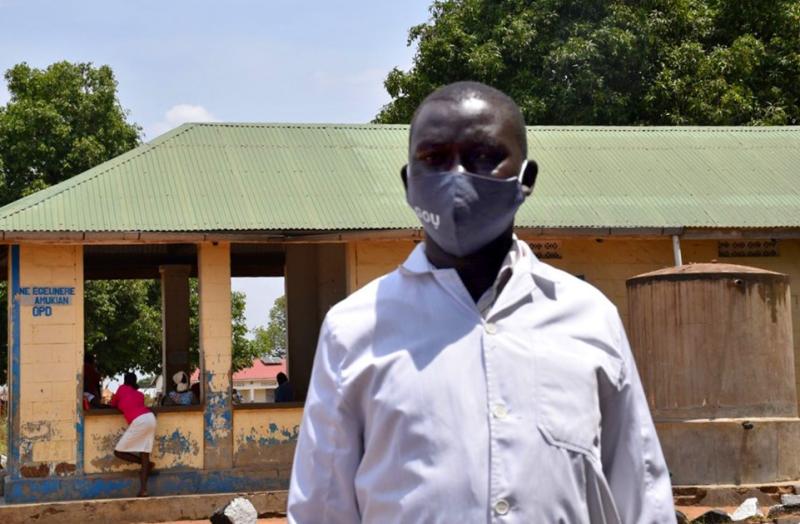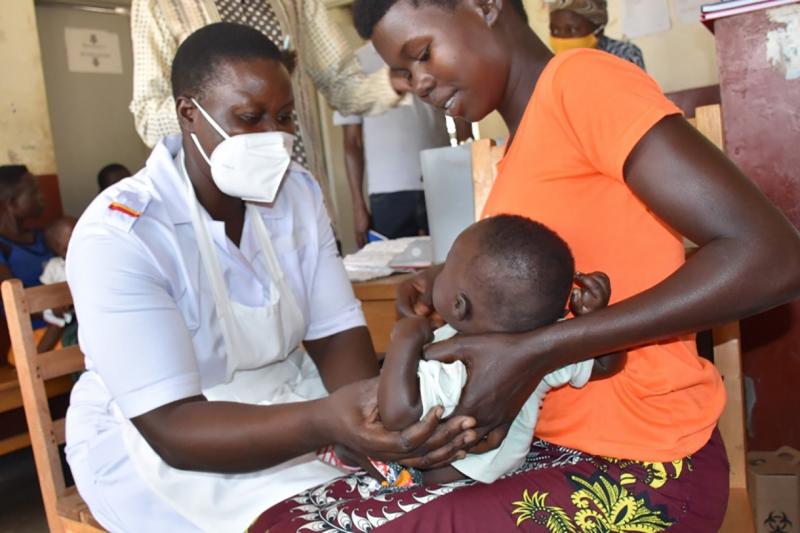Where We Work
See our interactive map


James Angedu at the Magoro Health Center III. Photo by Irene Mirembe for IntraHealth International.
Here's why his facility is seeing results.
It’s 10:45 am. The sun is already high in the sky and the heat is unrelenting at Magoro Health Center III in the Kakatwi District of Eastern Uganda.
Uganda is experiencing its dry season and patients usually stay away because of the heat, but not at this health facility.The reason: James Angedu, the health worker in charge.
At the peak of the COVID-19 pandemic in Uganda in October 2020, eight of James’s staff contracted COVID-19 and a member of the community had died of the disease. Work at the health facility came to a standstill. Fear and rumors spread about the highly infectious disease. Community members stopped coming to the health facility for much-needed health services like maternal and child care. Outpatient services dropped from 1,000 clients per day before the pandemic to 214 clients in October 2020, then 114 in November.
With help from IntraHealth International’s Regional Health Integration to Enhance Services in Eastern Uganda (RHITES-E) Activity, James worked to change that.
In March 2020, following presidential directives in Uganda, RHITES-E continued to work with the Ministry of Health to deliver high-quality health services in communities such as the one Magoro Health Center serves.
The project worked with James to form teams to identify and orient village health teams and build back confidence and trust in health services.The Magoro Health Center intensified its community activities, including:
Using program data, RHITES-E found a persistent low uptake of maternal health services. So the team reengaged community systems to bring back clients and ensure they receive health services
We knew what to do to bring back clients to care.
James wanted to ensure clients continued to get the high-quality maternal and child health services they needed despite the pandemic, so he worked smarter. Together with his health team, he took advantage of available opportunities to improve efficiency and deliver results.
“Strategies had to shift,” James says. “We knew where the challenges were, so we didn’t act without planning.”
The facility staff, supported by RHITES-E, went back to the basics and developed micro-plans to increase the use of health services, including integrating COVID-19 prevention messaging into their community outreach.

Sister Anyait Stella attends to a mother and her child at the Magoro Health Center. Photo by Irene Mirembe for IntraHealth International.
“We knew what to do to bring back clients to care,” James says. “For example, we integrated COVID-19 into our health education sessions on maternal and child health to bust myths and address fears—call it killing two birds with one stone.’’
The facility is in a community with many adolescents and young mothers, who are often at greater risk of losing access to care. To reach them, facility teams collaborated with outreach teams to expand their community education, including how to safely access services during COVID-19.
“Our clients are highly mobile and affected by serious barriers such as stigma and discrimination—and now COVID-19,” James says. “So focal persons tag along during the field and home visits to offer counseling.”
By January 2021, outpatient attendance had increased to 1,048 and the facility registered over 80 deliveries, an increase from below 50 deliveries between October and December 2020.
The facility hit its maternal and child health target, bringing clients back to the health facility.
“We had to collaborate with the community leaders to move the needle, so they are part of the whole facility and community approach to scale up service uptake,” James says. “The facility hit its maternal and child health target, bringing clients back to the health facility and surpassing their indicators.”
Other factors that have contributed to the facility’s success are the strong team of focal persons who work to improve the day-to-day operations of the facility. They are friendly and professional when dealing with clients. Each of the focal persons heads a sub-unit and they work together to ensure all the different care points are functional.
“The health worker in charge at Magoro HC III has demonstrated servant leadership,” says Dr. Rogers Masaba, RHITES-E malaria advisor, of James. “He is a team-builder and -player and his team observes and usually emulates him.”
A work plan was developed for health staff to follow and the health worker in charge rotates staff and developed an “employee of the quarter list” to keep them motivated.
Following RHITES-E’s support, the facility conducts timely logistics planning and as a result, the facility experiences no stock outs, which has kept clients flowing in for refills and services. The facility has also managed to integrate COVID-19 prevention messaging in its maternal and child health, family planning outreach, and antenatal care (ANC) screening activities. For example, laboratory officers have been trained to counsel clients who come in for early ANC screenings to also test them for first trimester ANC.
“This has increased the number of new mothers and improved ANC enrollment and retention,” says Stella, a registered midwife at Magoro Health Center III. “The volunteer health trainers and mentor mothers have tremendously supported clients to access and complete the various services being offered at the facility. They increase awareness, acceptability, and uptake of these services. This has improved service provision.”
RHITES-E is funded by the US Agency for International Development. It aims to reduce maternal, newborn, and child mortality and morbidity by focusing primarily on increasing clients’ use of critical services, with a focus on antenatal care (ANC), postnatal care (PNC), health facility deliveries, essential newborn care, integrated management of childhood illnesses (IMCI), and effective referral services.
Get the latest updates from the blog and eNews




